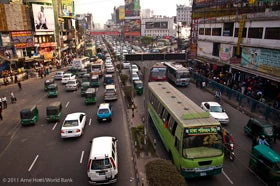
The relationship between urbanization and economic development has long been a popular issue of debate. Should a developing country encourage urbanization? While this is a real dilemma in Bangladesh, because of a highly unfavorable land-population balance, the only alternative Bangladesh has to urbanization is urbanization. The question is not whether Bangladesh should urbanize; the question is how Bangladesh will handle the challenges of urbanization.
Cities in Bangladesh are faced with the challenges of rapid population increase characterized by crises such as lack of economic dynamism, governance failure, severe infrastructure and service deficiencies, inadequate land administration, massive slums and social breakdown. However, urban centers continue to grow, despite the severity of these obstacles. As a result, urban areas in Bangladesh have exceptionally high population density, but relatively low economic density. High population density, combined with rapid urbanization, implies a large and fast-growing urban population to manage. Dhaka city, the largest urban conurbation in Bangladesh, is one of the most densely populated urban areas in the world. However, the economic density of Bangladesh’s urban areas (GDP or value-added per square km) is relatively low from an international perspective. Economic activity is concentrated in Dhaka and Chittagong. About 9% of the Bangladesh population lives in the Dhaka metropolitan area, which contributes to 36% of the country’s GDP. An additional 11% of the Bangladesh GDP is generated by Chittagong, the second-largest city and home to 3% of the population. The economic gap between Dhaka and Chittagong compared to other medium and small-size cities is large and widening.
Bangladesh needs to build an urban space that is capable of innovating, is better connected and more livable in order to make cities competitive. Bangladesh’s urban space is falling behind in all three of these drivers of competitiveness. The Dhaka metro area needs to evolve into a diversified economy with skilled human resources and an innovation capacity fueled by the cross-fertilization of ideas typical of large metropolitan areas. Dhaka metro area also needs to be better connected internally and with its peri-urban areas, and both Dhaka and Chittagong have to strengthen their connection to the global economy. Improved connectivity within Bangladesh’s system of cities is also important for productivity and export competitiveness. The development of an economically dynamic urban space, in particular in the Dhaka metro region, has occurred at the expense of livability. The livability of the urban space will become an even more binding constraint to sustained growth as Bangladesh transitions to a new business model based on higher-value industries and services, which need a highly skilled and internationally mobile workforce. This is a tall order for Bangladesh, but planning needs to start today for Bangladesh’s cities to become more competitive in future.
Urbanization have crucial role to play in the economic development of Bangladesh. The circumstances under which population in Dhaka and Chittagong are growing without proportionate infrastructural development will begin to wipe out most of the gains associated with urbanization. That is, relative high levels of urbanization may not be sufficient to ensure higher levels of economic welfare in Bangladesh. This has happened in Latin America with levels of urbanization, above 80%, yet with real per capita incomes about a third that of developed nations. It could happen in Bangladesh as well unless the urban managers rise from their prolonged slumber.


Join the Conversation